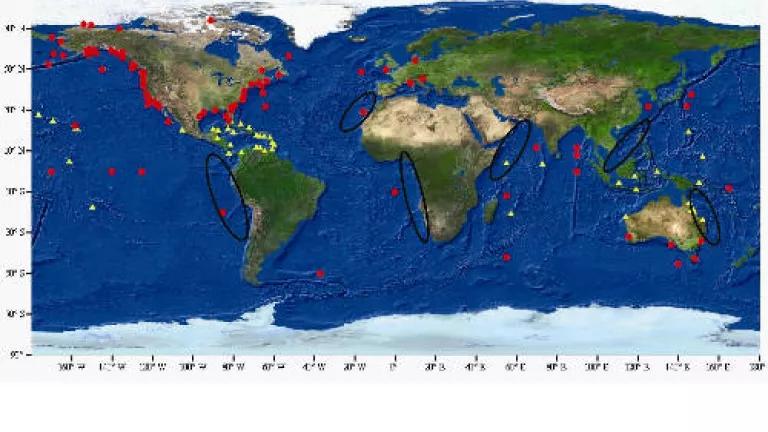
One year from now, nations from around the world will convene to discuss the future of our planet at the Earth Summit 2012. As NRDC’s President Frances Beinecke says so well, this global meeting must be one of action, and not of lofty promises.
There is precious little time to waste, and the issue of ocean acidification highlights the urgency for action. Carbon dioxide (CO2) from burning fossil fuels is changing the fundamental chemistry of our oceans. CO2 reacts with sea water to form carbonic acid. As atmospheric CO2 has risen, the oceans have become 30% more acidic over the last 150 years. This effect is measurable and undisputed, and affects all of the world’s oceans.
At the Earth Summit, NRDC is calling on the international community to develop, on an urgent basis, an integrated, international program aimed at monitoring the chemical and biological changes resulting from ocean acidification that are likely to have socio-economic consequences. Such a monitoring network is essential to provide coastal nations with the information necessary to prepare for the impacts of ocean acidification on fisheries, corals and marine food webs.
As NRDC’s movie ACID TEST so vividly illustrates, rising ocean acidity reduces the availability of carbonate, a critical component of shell-building. If acidity gets high enough, ocean water becomes corrosive and shells literally dissolve. Unchecked, ocean acidification could affect marine food webs and lead to substantial changes in commercial fish stocks, threatening protein supply and food security for millions of people as well as the multi-billion dollar global fishing industry. By mid-century vast ocean regions may be inhospitable to coral growth and reefs will begin to erode faster than they can grow. Regions dependent on healthy coral reefs for fisheries, tourism, and storm protection will be profoundly impacted.
Currently, there are only approximately 30 monitoring stations capable of measuring ocean acidity, and most of these are in developed countries. There is very little monitoring of biological impacts of acidification anywhere in the world. Without better monitoring it will not be possible to identify areas of vulnerability or develop effective mitigation measures and management strategies.
The single most important step we can take to address ocean acidification is to dramatically reduce CO2 emissions. But ocean acidification is already affecting marine life, and States and coastal communities need information that can help them assess risks, plan for impacts and initiate management strategies, including, for example:
Vulnerability Analyses – Based on current research and observations, scientists have identified broad geographic regions and marine species that are vulnerable. High latitudes, regions of upwelling, and coastal estuaries with heavy river input, will experience episodes of corrosive water first. In addition, certain species such as tropical corals and some oysters and other mollusks are particularly sensitive to changes in carbonate chemistry. There may be many other marine animals affected, and a more comprehensive and refined understanding of vulnerabilities is greatly needed.
Early warning systems - Real-time information about ocean chemistry can serve as an early warning system for already affected regions and industries. For example, oyster hatcheries along the west coast of the United States have deployed monitoring systems to alert their operators to episodes of corrosive which are harmful to larval oysters. With the use of these systems, hatchery owners have restored their production by 80% and have rescued their businesses.
Management guidance – Ocean acidification is happening against the backdrop of a rapidly changing ocean. In addition to changes in ocean chemistry, ocean water is getting warmer, oxygen availability is decreasing, and a host of local stressors exacerbate global change. Enhanced ocean observations are critically needed to improve ocean management in a changing world.
The map below illustrates current existing and planned monitoring stations (red circles and yellow triangles). The ovals identify areas likely to experience the impacts of ocean acidification soonest. The entire Arctic Ocean and Southern Ocean are also likely to experience impacts in the near future. Supplementing the existing network is estimated to cost in the neighborhood of $50 million – a small investment that will allow coastal States and communities to plan for the future.
Feely et al., 2009. Red circles represent deployed or planned open-ocean monitoring sites; yellow triangles represent deployed or planned coral reef monitoring sites. Ovals represent areas likely to experience ocean acidification impacts soonest. Arctic and Antarctic marine ecosystems are also likely to experience impacts in the near future.

